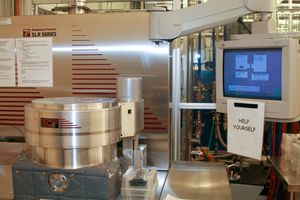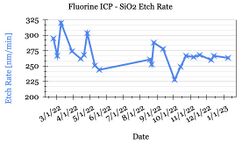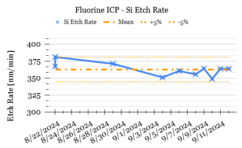Fluorine ICP Etcher (PlasmaTherm/SLR Fluorine ICP): Difference between revisions
Freeborn d (talk | contribs) (Removed reference to the Bosch process.) |
|||
| (38 intermediate revisions by 5 users not shown) | |||
| Line 1: | Line 1: | ||
| ⚫ | |||
'''Note: This page needs to updated''' - it is still showing old information from before it was converted to a Fluorine etcher. It is not a Silicon Bosch Etcher any more. |
|||
| ⚫ | |||
|picture=SiDeep.jpg |
|picture=SiDeep.jpg |
||
|type = Dry Etch |
|type = Dry Etch |
||
|super= |
|super= Tony Bosch |
||
|super2= Aidan Hopkins |
|||
|phone= 805-893- |
|phone= 805-893-3486 |
||
|location=Bay 2 |
|location=Bay 2 |
||
|email= |
|email=bosch@ece.ucsb.edu |
||
|description = SiRIE Based Flourine Etcher for Bosch MEMS Processes |
|description = SiRIE Based Flourine Etcher for Bosch MEMS Processes |
||
|manufacturer = Plasmatherm (Unaxis) |
|manufacturer = Plasmatherm (Unaxis) |
||
|model = SLR Series |
|||
|materials = |
|materials = |
||
|toolid=28 |
|toolid=28 |
||
}} |
}} |
||
= |
=About= |
||
The system is a Plasma-Therm 770 SLR series system with a loadlock. The system has an Inductively Coupled Plasma (ICP) coil and a capactively coupled substrate RF supply to independently control plasma density and ion energy in the system. The system is fully computer controlled in all aspects of the pumping cycles and process control, and can be programmed by the user |
The system is a Plasma-Therm 770 SLR series system with a loadlock, dedicated to fluorine-based gases (system aka. "FL-ICP"). The system has an Inductively Coupled Plasma (ICP) coil and a capactively coupled substrate RF supply to independently control plasma density and ion energy in the system. Helium back-side cooling is available to keep the sample cool during the etch. The system is fully computer controlled in all aspects of the pumping cycles and process control, and can be programmed by the user. |
||
The system is generally meant for any fluorine-containing etch, which is typically for etching materials like SiO<sub>2</sub>, Si<sub>3</sub>N<sub>4</sub>, Silicon, or other materials with volatile fluoride etch products. |
|||
The materials allowed in the system are limited to Silicon, SiO<sub>2</sub>, Si<sub>3</sub>N<sub>4</sub>, SiO<sub>X</sub>N<sub>Y</sub>, and polymer films such as photoresist, PMMA, and polyimide. Other materials can be placed in the chamber, such as metal layers on the surface, only if they will remain completely protected from the plasma by an allowed material during the entire etch. Some alternate stop-etch materials may be allowed upon discussion with facility staff. |
|||
The fixturing is configured for 4" diameter Si wafers and uses a ceramic clamp on the outer ~5mm of the 100mm wafer to hold the sample on the RF chuck. |
|||
Helium back-side cooling is used to keep the sample cool during the etch. Temperature control is very important as the polymer passivation layer is chemically etched away by the fluorine gas at elevated temperatures, resulting in loss of profile control. Pieces of wafers can be mounted onto 4" silicon wafers using thin, uniform, bubble-free hard baked photoresist. The etch rate is dependent on the open area of silicon (macro-loading effect) with large open area samples etching slower than small open area samples. Features with a high aspect ratio will also etch slower than more open areas. This is known as RIE lag or the micro-loading effect. |
|||
Smaller samples can be mounted onto 100mm carrier wafers, either with no adhesive (sample temperature will be higher), or with Santovac oil for better thermal cooling. However, <u>great care must be taken</u> to ensure no oil, photoresist or small pieces are placed on the outer 5mm of the carrier wafer, as the ceramic clamp will physically press on this outer region, potentially causing stiction or wafer breakage if foreign or sticky substances are in those regions. |
|||
| ⚫ | |||
The in-situ [[Laser Etch Monitoring|laser monitor]] installed on the chamber allows for repeatable etches and endpoint detection via continuous optical monitoring of the wafer reflectivity in a user-determined location, through a porthole on the chamber. |
|||
| ⚫ | |||
| ⚫ | |||
| ⚫ | |||
| ⚫ | |||
| ⚫ | |||
| ⚫ | |||
*Allowed materials: Silicon, SiO<sub>2</sub>, Si<sub>3</sub>N<sub>4</sub>, SiO<sub>X</sub>N<sub>Y</sub>, and polymer films such as photoresist, PMMA, and polyimide; other stop-etch materials on request |
|||
| ⚫ | |||
*Realized etch rates (including passivation steps) of > 3 um / min. Using the standard Plasma Therm recipe, a nominal etch rate of 2 um / min. is achieved; etch rate dependent on conditions and open area |
|||
| ⚫ | |||
| ⚫ | |||
*Single 100mm/4-inch wafer handling with physical topside clamp, contacting outer 5mm of wafer. |
|||
**Small samples may be mounted with oil or no adhesive, but must be far away from this 5mm edge exclusion zone. |
|||
**No photoresist or oil is allowed to contact the clamp, or wafers will get stuck and possibly break in the chamber. |
|||
| ⚫ | |||
**Easy to chain recipes via "Batch" programming, eg. ''SiO2 Etch / Si Etch / PR strip'' in a single load. |
|||
| ⚫ | |||
=Documentation= |
=Documentation= |
||
*{{file|Si Deep RIE Operating Instructions.pdf|Si Deep RIE Operating Instructions}} |
|||
*{{file|Running_a_process_on_Plasma_Therm_SLR.pdf|Fluorine Etcher Operating Instructions (Cortex Software)}} |
|||
| ⚫ | |||
| ⚫ | |||
*[[Laser Etch Monitoring|Laser Monitor procedures]] |
|||
*[https://wiki.nanotech.ucsb.edu/w/images/6/65/Editing_a_Recipe_on_Plasma.pdf How to edit recipe] |
|||
*[https://wiki.nanotech.ucsb.edu/w/images/6/69/Cleaning_Rules_for_Fluorine_ICP_Etch_tool.pdf Cleaning rules] |
|||
*[[Photolithography - Manual Edge-Bead Removal Techniques|Manual Edge-Bead Removal Techniques]] - 5mm of outer edge must be free of photoresist, use these techniques to accomplish that for full wafers. |
|||
| ⚫ | |||
*Recipes > [[Dry Etching Recipes|Dry Etching]] > [https://wiki.nanotech.ucsb.edu/w/index.php?title=ICP_Etching_Recipes#PlasmaTherm.2FSLR_Fluorine_Etcher '''PlasmaTherm/SLR Fluorine Etcher'''] |
|||
**Starting point recipes for the FL-ICP, including SiO<sub>2</sub> and Si etches. |
|||
**''Process Control Data'' records "calibration" etches to test tool performance. |
|||
*You can see a full list of all tools and all materials able to be etched on our [[Dry Etching Recipes|Dry Etching Recipes Table]]. |
|||
===Process Control Data=== |
|||
We have two different EtchCals on this tool: |
|||
==== SiO<sub>2</sub> Etching ==== |
|||
''We have found that SiO<sub>2</sub> etching is fairly insensitive to chamber condition.'' |
|||
*[https://docs.google.com/spreadsheets/d/15hYkCqL3UNNayt4sXrvVi4mBj-OSdnF7PE29mQW9AEY/edit?usp=sharing SiO<sub>2</sub> Etching with CHF<sub>3</sub>/CF<sub>4</sub> - '''Etch Data'''] |
|||
*[https://docs.google.com/spreadsheets/d/15hYkCqL3UNNayt4sXrvVi4mBj-OSdnF7PE29mQW9AEY/edit#gid=1804752281 SiO<sub>2</sub> Etching with CHF<sub>3</sub>/CF<sub>4</sub> - '''Plots'''][[File:FL-ICP Process Control Data Example.jpg|alt=example of Process Control Charts|none|thumb|242x242px|[https://docs.google.com/spreadsheets/d/15hYkCqL3UNNayt4sXrvVi4mBj-OSdnF7PE29mQW9AEY/edit#gid=1804752281 Click for Process Control Charts]|link=https://docs.google.com/spreadsheets/d/15hYkCqL3UNNayt4sXrvVi4mBj-OSdnF7PE29mQW9AEY/edit#gid=1804752281]] |
|||
==== '''Si Etching''' ==== |
|||
''This Si etch is much more sensitive to chamber condition, allowing us to detect chamber contamination faster.'' |
|||
*[https://docs.google.com/spreadsheets/d/15iRs-JhfgkMto5rZVtG0hJjcLMiHy039_ahv2nus0UQ/edit?gid=0#gid=0 Si Etching with C<sub>4</sub>F<sub>8</sub>/SF<sub>6</sub>/CF<sub>4</sub> - '''Etch Data'''] |
|||
| ⚫ | |||
*[https://docs.google.com/spreadsheets/d/15iRs-JhfgkMto5rZVtG0hJjcLMiHy039_ahv2nus0UQ/edit?gid=1804752281#gid=1804752281 Si Etching with C<sub>4</sub>F<sub>8</sub>/SF<sub>6</sub>/CF<sub>4</sub> - '''Plots'''][[File:FICP-Si.png|alt=example of Process Control Charts|none|thumb|242x242px|[https://docs.google.com/spreadsheets/d/15iRs-JhfgkMto5rZVtG0hJjcLMiHy039_ahv2nus0UQ/edit?gid=1804752281#gid=1804752281 Click for Process Control Charts]|link=https://docs.google.com/spreadsheets/d/15iRs-JhfgkMto5rZVtG0hJjcLMiHy039_ahv2nus0UQ/edit?gid=1804752281#gid=1804752281]] |
|||
Etch recipes can be found on the following page: [[ICP_Etching_Recipes#Si_Deep_RIE_.28PlasmaTherm.2FBosch_Etch.29 | Dry Etching Recipes > Si Deep RIE (PlasmaTherm/Bosch Etch)]] |
|||
Latest revision as of 21:39, 6 November 2024
| ||||||||||||||||||||||||||||||||
About
The system is a Plasma-Therm 770 SLR series system with a loadlock, dedicated to fluorine-based gases (system aka. "FL-ICP"). The system has an Inductively Coupled Plasma (ICP) coil and a capactively coupled substrate RF supply to independently control plasma density and ion energy in the system. Helium back-side cooling is available to keep the sample cool during the etch. The system is fully computer controlled in all aspects of the pumping cycles and process control, and can be programmed by the user.
The system is generally meant for any fluorine-containing etch, which is typically for etching materials like SiO2, Si3N4, Silicon, or other materials with volatile fluoride etch products.
The fixturing is configured for 4" diameter Si wafers and uses a ceramic clamp on the outer ~5mm of the 100mm wafer to hold the sample on the RF chuck.
Smaller samples can be mounted onto 100mm carrier wafers, either with no adhesive (sample temperature will be higher), or with Santovac oil for better thermal cooling. However, great care must be taken to ensure no oil, photoresist or small pieces are placed on the outer 5mm of the carrier wafer, as the ceramic clamp will physically press on this outer region, potentially causing stiction or wafer breakage if foreign or sticky substances are in those regions.
The in-situ laser monitor installed on the chamber allows for repeatable etches and endpoint detection via continuous optical monitoring of the wafer reflectivity in a user-determined location, through a porthole on the chamber.
Detailed Specifications
- 1000 W ICP coil power at 2 MHz and 500 W substrate bias at 13.56 MHz plasma generators
- C4F8, SF6, O2, Ar, N2, CHF3, CF4 gases available
- He-back-side cooling, 10°C std. chuck temp.
- Single 100mm/4-inch wafer handling with physical topside clamp, contacting outer 5mm of wafer.
- Small samples may be mounted with oil or no adhesive, but must be far away from this 5mm edge exclusion zone.
- No photoresist or oil is allowed to contact the clamp, or wafers will get stuck and possibly break in the chamber.
- Windows-based computer control of process and wafer handling
- Easy to chain recipes via "Batch" programming, eg. SiO2 Etch / Si Etch / PR strip in a single load.
- Laser endpoint monitoring with camera and simulation software, for repeatable etching - see: Intellemetrics LEP 500
Documentation
- How to restart software on Plasma-Therm Cortex Software
- Laser Monitor procedures
- How to edit recipe
- Cleaning rules
- Manual Edge-Bead Removal Techniques - 5mm of outer edge must be free of photoresist, use these techniques to accomplish that for full wafers.
Recipes
- Recipes > Dry Etching > PlasmaTherm/SLR Fluorine Etcher
- Starting point recipes for the FL-ICP, including SiO2 and Si etches.
- Process Control Data records "calibration" etches to test tool performance.
- You can see a full list of all tools and all materials able to be etched on our Dry Etching Recipes Table.
Process Control Data
We have two different EtchCals on this tool:
SiO2 Etching
We have found that SiO2 etching is fairly insensitive to chamber condition.
Si Etching
This Si etch is much more sensitive to chamber condition, allowing us to detect chamber contamination faster.


